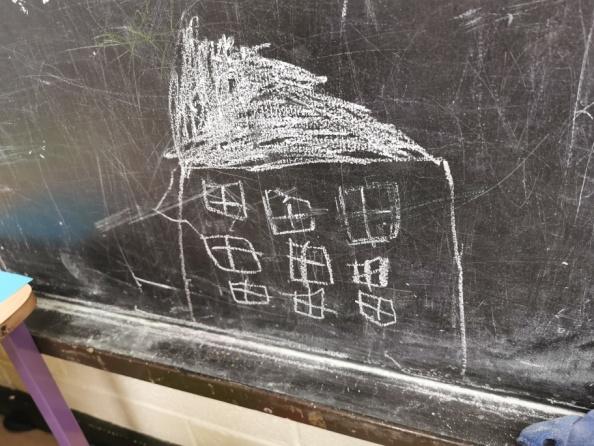Mark making during play can be encouraged and used as a tool to reflect and review after play. Observe the type of language children use to explain their play. Children’s discussion about their mark making embodies mathematical language naturally in order for them to explain ‘what is going on’ in their picture. Adopt the mantra ‘Notice, Explore and Talk about Mathematics’ when discussing mark making with the children. Below you can see some examples of mark making and mathematical language opportunities.
Child: ‘My house has 4 layers. ‘
Teacher: ‘Four layers, can you show me what you mean?’
Child: Points to each level ‘1,2,3,4’
Child: ‘My house is a very big house, I have lots of windows’
Child: ‘We have a window on top’
Mathematical Language Opportunities explored:
- Number
- Size
- Spatial awareness
- Shape and space
Child: ‘I built your house teacher’
‘It is a very big house’
Teacher: ‘Why did you build Teacher a big house?’
Child: ‘..because you are big and I think you are great’
Teacher: ‘Thank you very much, can you tell me more about this big house?
Mathematical Language opportunities explored:
- Number
- Size
- Spatial awareness
- 2D Shapes
- Problem-solving
‘These are my customers, they use a lift, they press number 3’
‘I have 10 tables, loads of people can eat here’.
Mathematical Language opportunities explored:
- Number
- Operations
- Size
- Spatial awareness
- 2D Shapes
- Problem-solving
‘We built our cafe together all of us did it‘,
‘It is a cafe for 90 people’,
‘It has four layers’
Mathematical Language opportunities explored:
- Numbers
- Operations
- Size
- Spatial awareness
- 2-D shape
- Problem-solving
‘This is my granny’s house. She lives in the first house. It is a big house’.
Mathematical Language opportunities explored:
- Ordinal number
- Number
- 2D Shape
- Spatial Awareness
- Size
References
- Brennan, C. (2014) Inquiring about Life through Play. Barnardos Links Magazine, Autumn, 34-40.
- Clements, D., H. & Sarama, J. (2014) Learning and Teaching Early Math: The Learning Trajectories Approach. Second ed. New York; London: Routledge
- Dooley, T., Dunphy, E., & Shiel, G. (2014) Mathematics in Early Childhood and Primary Education. Research Report 18 [online]. Dublin: National Council for Curriculum and Assessment.
- Dunphy, E., Dooley, T., & Shiel, G. (2014) Mathematics in Early Childhood and Primary Education. Definitions, Theories, Development and Progression. Research Report 17 [online]. Dublin: National Council for Curriculum and Assessment.
- Edwards, C., Gandini, L. and Forman G. (2012) The Hundred Languages of Children: The Reggio Emilia Experience in Transformation (3rd Ed) California: Praeger.
- French, G. (2013) Early literacy and numeracy matters. Journal of Early Childhood Studies [online]. 7(April).
- Ginsburg, H.P. (2016) Helping early childhood educators to understand and assess young children’s mathematical minds. ZDM Mathematics Education, 48, 941–946.
- Ginsburg, H. (2006) Mathematical play and playful mathematics: A guide for early education. In: Singer, D. G., Golinkoff, R.M. & Hirsh-Pasek, K. eds. Play = Learning: How Play Motivates and Enhances Children’s Cognitive Social-emotional Growth. New York, NY: Oxford University Press. 145–166.
- Ginsburg, H., Lee, J., & Boyd, J. (2008) Mathematics education for young children: What it is and how to promote it. Social Policy Report, XX11( 1)
- Gopnik, A. (2012) Scientific Thinking in Young Children: Theoretical Advances, Empirical Research, and Policy Implications. Science, 337(6102), 1623-1627.
- Gray, P. (2017) What Exactly Is Play, and Why Is It Such a Powerful Vehicle for Learning? Topics in Language Disorders, 37(3), 217-228.
- Mardell, B., Wilson, D., Ryan, J., Ertel, K., Krechevsky, M and Baker, M. (2016) Towards a Pedagogy of Play. A Project Zero Working Paper [online].
- National Council for Curriculum and Assessment (2020) The Building Blocks of Early Mathematics [online]. Dublin: National Council for Curriculum and Assessment.
- National Council for Curriculum and Assessment (2009) Aistear. The Early Childhood Framework [online]. Dublin: National Council for Curriculum and Assessment.
- Perry, B. & Dockett, S. (2007) Play and Mathematics. Adelaide: Australian Association of Mathematics Teachers.
- Stafford, P. (2012) Numeracy through Play in Infant Classes: How Play Helps Numeracy Development [online]
- The Smith Family. (2015) Strengthening Early Numeracy Learning: The Let’s Count Program In. Perry, B. & Dockett, S. (2018) Using a bioecological framework to investigate an early childhood mathematics education intervention. European Early Childhood Education Research Journal, 26(4), 604-617.
- Weisberg, D. S., Hirsh-Pasek, K., Golinkoff, R. M., Kittredge, A.K. & Klahr, D. (2016) Guided Play: Principles and Practices. Current Directions in Psychological Science, 25(3), 177–182.
- Wickstrom, H., Pyle, A. & De Luca, C. (2019) Does Theory Translate into Practice? An Observational Study of Current Mathematics Pedagogies in Play-Based Kindergarten. Early Childhood Education Journal [online]. 47(3), 287–295.










